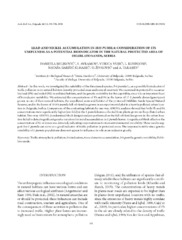Приказ основних података о документу
LEAD AND NICKEL ACCUMULATION IN IRIS PUMILA: CONSIDERATION OF ITS USEFULNESS AS A POTENTIAL BIOINDICATOR IN THE NATURAL PROTECTED AREA OF DELIBLATO SANDS, SERBIA
| dc.creator | Miljković, Danijela | |
| dc.creator | Avramov, Stevan | |
| dc.creator | Vujić, Vukica | |
| dc.creator | Rubinjoni, Luka | |
| dc.creator | Barišić Klisarić, Nataša | |
| dc.creator | Živković, Uroš | |
| dc.creator | Tarasjev, Aleksej | |
| dc.date.accessioned | 2016-05-23T11:00:48Z | |
| dc.date.available | 2016-05-23T11:00:48Z | |
| dc.date.issued | 2014 | |
| dc.identifier.issn | 1821-4339 | |
| dc.identifier.uri | https://radar.ibiss.bg.ac.rs/handle/123456789/2303 | |
| dc.description.abstract | In this work, we investigated the suitability of the threatened species, Iris pumila L., as a possible bioindicator of traffic pollution in its natural habitats (mostly protected areas and natural reserves). We examined its potential to accumulate lead (Pb) and nickel (Ni) in polluted habitats, and the genetic variability for this capability, since it is an important facet of bioindicator suitability. We estimated the concentrations of Pb and Ni in the leaves of 17 I. pumila clones (genotypes) grown in one of their natural habitats, the unpolluted semi-arid habitat of the protected Deliblato Sands Special Natural Reserve, and in the leaves of 18 Iris pumila full-sib families grown in an experimental plot in a heavily polluted urban location in Belgrade, Serbia. Comparison of the contrasting habitats by one-way ANOVA analysis showed that both Pb and Ni concentrations were significantly higher (six-fold) in the I. pumila leaves collected from plants grown in the polluted urban habitat. Two-way ANOVA (randomized block design) analysis performed on the full-sib families grown in the urban location failed to detect significant genetic variation for metal accumulation in I. pumila leaves. A significant block effect on the concentration of Ni in leaves was detected, indicating responsiveness to microenvironmental variability. These results suggest that I. pumila can serve as a good indicator of traffic pollution in protected areas. The response is stable since genetic variability of I. pumila populations does not appear to influence its role as an indicator greatly. | en |
| dc.description.sponsorship | Ministry of Education, Science and Technological Development of Serbia {[}OI 173025] | |
| dc.language | English | |
| dc.relation | info:eu-repo/grantAgreement/MESTD/Basic Research (BR or ON)/173025/RS// | |
| dc.rights | openAccess | |
| dc.rights.uri | https://creativecommons.org/licenses/by-nc-nd/4.0/ | |
| dc.source | Archives of Biological Sciences | |
| dc.subject | Traffic atmospheric pollution | |
| dc.subject | bioindicators | |
| dc.subject | trace elements accumulation | |
| dc.subject | Iris pumila | |
| dc.subject | genetic variability | |
| dc.subject | Deliblato sands | |
| dc.title | LEAD AND NICKEL ACCUMULATION IN IRIS PUMILA: CONSIDERATION OF ITS USEFULNESS AS A POTENTIAL BIOINDICATOR IN THE NATURAL PROTECTED AREA OF DELIBLATO SANDS, SERBIA | en |
| dc.type | article | |
| dc.rights.license | BY-NC-ND | |
| dcterms.abstract | Зивковиц, У.; Клисарић-Барисић, Наташа; Рубињони, Л.; Вујиц, Вукица; Aврамов, Стеван Н.; Миљковић, Данијела П.; Тарасјев, A.; | |
| dc.rights.holder | © 2014 Serbian Biological Society | |
| dc.citation.issue | 1 | |
| dc.citation.volume | 66 | |
| dc.identifier.doi | 10.2298/ABS1401331M | |
| dc.identifier.scopus | 2-s2.0-84892377749 | |
| dc.identifier.wos | 000330552400042 | |
| dc.citation.spage | 331 | |
| dc.citation.epage | 336 | |
| dc.type.version | publishedVersion | en |
| dc.identifier.fulltext | https://radar.ibiss.bg.ac.rs/bitstream/id/6009/0354-46641401331M.pdf | |
| dc.citation.rank | M23 |

